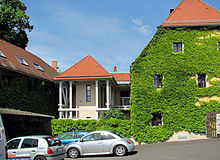Oberschänke
The Oberschänke is a more than 500 year old, mostly gastronomically used property on Anger Altkötzschenbroda in the Radebeul district of Kötzschenbroda . The building, which is now a listed building, forms the eastern end of both Angers and the square in front of the Friedenskirche . The outbuildings of the Oberschänke form a boundary wall of the churchyard .
description
The distinctive two-storey plastered building with a high tiled hipped roof and four window axes faces the anger with the gable side, while the eaves side with eight axes stands on a street passage to the old village center of Fürstenhain . The outbuildings adjoining the main building to the south, in which the brewery, the kiln and other utility rooms were previously housed, face the eaves facing the green and close it off to the east. In the south they border directly on the churchyard, where they close it to the north.
history
Kötzschenbroda was first mentioned in 1226 as Schozebro , where the manor of Zisimo de Schozebro was located . This knight's seat was "at the place of the upper tavern at the highest point on the site", as can be clearly seen there "in the aerial photo by the position of barns". In 1497, in the oldest surviving Kötzschenbrodaer Dorfrügen , also called Thanneberger Rügen after the scribe , two existing Kretzscham ( brewery goods ) were mentioned, the Oberschänke on the market by the Friedenskirche and the Niederschänke (today the Goldener Anker ). The location of the Oberschänke on the old market square right next to the church leads to the conclusion that the history of the Oberschänkengut, as the older of the two Kretzschams, goes back to the time the village was founded. In 1508 Gregor Vogt was named as the oldest Oberkretzschmar (brewery innkeeper) known by name.
The village fires of 1598 and 1672 destroyed the pub and brewery, in 1693 it was a self-inflicted fire that destroyed the stables, the barn, a moving house and a wine press. The buildings rebuilt afterwards form the core of today's inn.
The Seifert family owned the brewery estate from 1737 to 1847. The baroque family grave of Karl August Seifert (1799–1843) is in the neighboring churchyard .
In 1742, the brewers of the Oberschänke, the Niederschänke and the inn in Naundorf sued the innkeeper of the Winkelschänke on the Liborius vineyard to the north, for illegally serving beer from Cossebaude and Oberwartha in his wine bar . The lawsuit was rejected, however, because "the Kötzschenbroda judges and court scouts described the beer in their own taverns as bad and undrinkable".
In 1857 parts of the estate were sold to different owners. In 1858 the municipal council applied to the court office in Dresden to convert the main building. It was described as a massive basement with a half-timbered upper floor with a hall.
The brewery and restaurant went to master brewer Julius Hermann Große in 1869, and the property remained in his family until 1965. The brewing operations of the Kötzschenbroda Julius H. Große brewery were discontinued in 1915 and resumed as the Paul Große Brewery from 1920 at the latest , and later continued under the name Martha Große until the Second World War. In 1952 the restaurant was given up.
After extensive renovation, the restaurant was reopened in 1996.
literature
- Frank Andert (Red.): Radebeul City Lexicon . Historical manual for the Loessnitz . Published by the Radebeul City Archives. 2nd, slightly changed edition. City archive, Radebeul 2006, ISBN 3-938460-05-9 .
- Volker Helas (arrangement): City of Radebeul . Ed .: State Office for Monument Preservation Saxony, Large District Town Radebeul (= Monument Topography Federal Republic of Germany . Monuments in Saxony ). SAX-Verlag, Beucha 2007, ISBN 978-3-86729-004-3 .
Web links
Individual evidence
- ^ Large district town of Radebeul (ed.): Directory of the cultural monuments of the town of Radebeul . Radebeul May 24, 2012, p. 1 (Last list of monuments published by the city of Radebeul. The Lower Monument Protection Authority, which has been located in the Meißen district since 2012, has not yet published a list of monuments for Radebeul.).
- ^ Heinrich Magirius : Village centers in the Lößnitz - their historical and urban significance and problems of their preservation as monuments. In: Dresdner Geschichtsverein (ed.): Lößnitz − Radebeul cultural landscape. (= Dresdner Hefte Nr. 54), Verlag Dresdner Geschichtsverein, Dresden 1998, ISBN 3-910055-44-3 , pp. 62–68.
- ^ Frank Andert (Red.): Radebeul City Lexicon . Historical manual for the Loessnitz . Published by the Radebeul City Archives. 2nd, slightly changed edition. City archive, Radebeul 2006, ISBN 3-938460-05-9 , p. 146 .
- ↑ Brief historical overview and chronology of the Niederschänke on the website of the current operator.
- ^ Brewery Kötzschenbroda Julius H. Große
Coordinates: 51 ° 6 ′ 15.5 ″ N , 13 ° 38 ′ 3 ″ E



